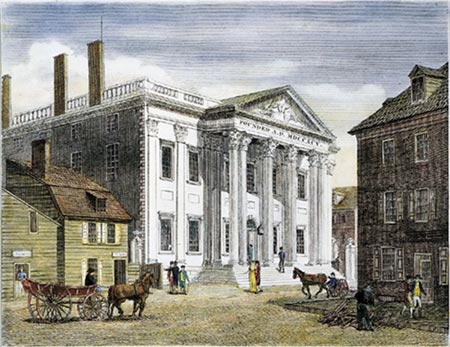First Bank
of the United States.

The war left us in debt. Some states were bankrupt. We needed one unified currency. Hamilton suggested a central bank.
The First Bank of the United States was needed because the government had a debt from the Revolutionary War, and each state had a different form of currency. It was built while Philadelphia was still the nation's capital. Alexander Hamilton conceived of the bank to handle the colossal war debt — and to create a standard form of currency.
Up to the time of the bank's charter, coins and bills issued by state banks served as the currency of the young country. The First Bank's charter was drafted in 1791 by the Congress and signed by George Washington. In 1811, Congress voted to abandon the bank and its charter. The bank was originally housed in Carpenters' Hall from 1791 to 1795. The neo-classical design of the bank was intended to recall the democracy and splendor of ancient Greece. When you're there, note the eagle which crowns the two-story portico. At the time of the bank's creation the eagle had been our national symbol for only 14 years. The bank building was restored for the Bicentennial in 1976.
- Oldest bank building in America
- Considered the oldest building in America with a classical facade
- Bank charter was in effect for only 20 years
- It cost $110,168.05 to build.
- Location: Third Street, between Chestnut and Walnut Streets
- Built: 1795-97
- Architects: Samuel Blodgett/James Windrim
- Style: Classical Revival
- Commissioned by: Congress on Hamilton's suggestion
- Tourism information: Not currently to the public. Independence National Historical Park will be opening a museum dedicated to Alexander Hamilton and the birth of the U.S. financial system in the bank. There is no date as yet for when this will be open to the public.
- Facilities: outdoor seating



